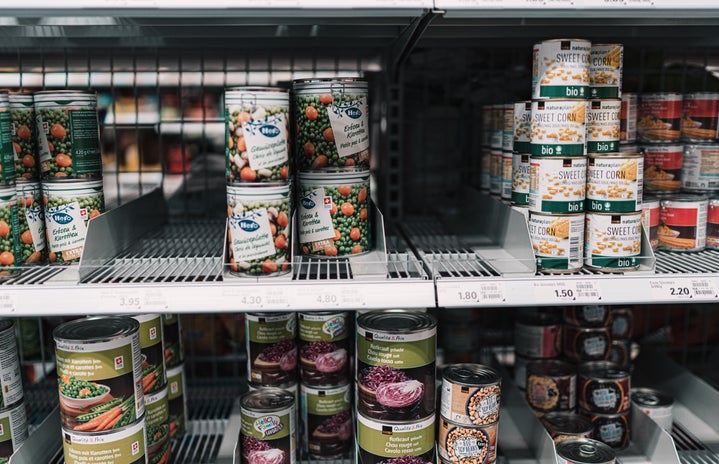If you’re a college student like me, I think you should be eating more beans. That sounds a little bit ridiculous, but I’m genuinely serious. They’re incredibly nutritious, incredibly versatile and easy to cook with. Most varieties of beans are about $0.75-1.00 a can, depending on where you’re shopping, making them a super affordable staple, even when you don’t have the time to buy dried beans and soak and cook them (something I’ve personally not tried yet). Depending on what you’re using them in, I’ve found that one can of beans is enough for about two servings, but if you combine with many other ingredients they can go even further. They’re also adaptable to tons of dietary restrictions (unless you can’t eat legumes, in which case, I’m sorry). If you’re a little bit hesitant about it, or need some ideas, you’re in the right place. Here are some of my favorite things to make with different types of beans.
Chickpeas
If you have access to an oven, chickpeas make a delicious and super simple meal when you throw them on a sheet pan with some of your favorite veggies, some oil, and seasonings and bake until everything is cooked through and starting to get a little bit of color on it. I typically set my oven to around 375º when baking things like this. Serve with your favorite carb (think quinoa, rice, or even potatoes), and, if you’re feeling fancy, a sauce. It’s a great way to put together a balanced meal without too much thought or prep, and not very many dishes. It can take a little while to bake, but it doesn’t require a lot of babysitting, so you have time to be productive and do some homework while your food is in the oven—or you can just relax. After the first 20 or so minutes, be prepared to check it every 5-10 until it’s ready. Last week I made a version of this with chickpeas, carrots, and cauliflower, but in the past I’ve used sweet potato, brussel sprouts, bell peppers, onions, broccoli and more. The best thing about this is that it’s super customizable to whatever you have in your fridge and pantry, or whatever you like best. Don’t overthink it!
black beans
Black beans are just as versatile as any other kind of bean, but my personal favorite way to have them is relatively plain, just seasoned and warmed up. That might sound a little bit questionable, but trust me. Typically, I’ll finally dice up some onion (and sometimes minced bell/jalapeño peppers) and saute in a little bit of oil, followed by some garlic. Then I rinse and drain a can of beans, and add them in, along with some spices. Often, I’ll use granulated garlic and onion (yes, even though there’s already garlic and onion), paprika, cumin, chili powder, cayenne pepper, and salt and pepper. Then, it’s just a matter of heating through and cooking until the flavor and texture are to your preference. I personally prefer to smash up some of the beans for a little bit of a varied texture. I’ve cooked beans this way for all kinds of meals: nachos with chips, rice bowls, tacos, and sometimes just to have on their own. It’s not essential, but I bought a bag of dried guajillo chiles for a recipe recently, and since then I’ve also enjoyed tossing one or two in with beans when they’re cooking for some extra depth of flavor.
great northern or Cannellini beans
These are technically two types of beans, but I use them pretty interchangeably. However, I will give you two recipes since there are two types. First up is soup. I love beans as a protein in a soup, whether it’s totally vegetarian/vegan or an accompaniment to sausage or meatballs. With white beans like these, I’ll most often put them in a soup along the lines of zuppa toscana or Italian wedding soup. Typically, that looks something like finely dicing up some onion and sauteing, then adding garlic and red pepper flakes (optional, but helps build flavor! And I love a little kick). If you’re using sausage, add that in and brown it, and then water or broth, along with any more herbs or seasonings. Bring to a boil, if you’re adding potatoes do that, and then reduce to a simmer. If you’re cooking meatballs in the soup, those can also be added before you reduce to a simmer, but make sure to only add a few at a time so that they don’t clump up. Then, simmer until everything is cooked through, adjust seasonings as needed, and then add in a generous amount of fresh or frozen spinach or kale (I tend to be very generous with the spinach and kale, but you can put more or less depending on your own preference). This soup is great to make ahead of time for meal prep or to reheat on a day when you don’t have too much time.
The other thing I typically make with great northern or cannellini beans is pasta. I’ve made pasta with red sauce and white beans, inspired by @haileecatalano on Instagram, and loved it—it’s a new basic meal format for me—but if you’re not a fan of tomato based pasta dishes, there are lots of other options. I really enjoy a sort of aglio e olio-inspired version, where you sauté minced garlic, red pepper, and white beans in a generous amount of olive oil until flavorful and tender, and then toss your favorite shape of pasta in it until nicely coated. Beans are overall a great way to make pasta more filling and nutritious, and there are so many things you can do with it. I find a lot of inspiration, especially for dishes like this, on social media.
butter beans
Butter beans are a little bit pricier than other beans, but they’re still less than two dollars a can. I love butter beans in a creamy sauce, and I usually eat them with bread or pasta. As I said earlier, social media is a fantastic place to find recipes, especially for butter beans, which is where I discovered my personal favorite version, a paprika-based, saucy butter bean recipe (from @carole.food on TikTok). Delicious, and only one of a bunch of recipes that I’ve tried. You can also feel free to free-style, using your favorite base (something like yogurt, broth, tahini, the options are endless) and adding seasonings and other vegetables (I personally love spinach or tomatoes) until you’ve created something you like.
I hope some of these ideas have been helpful to you, and encouraged you to try something new. But, even if they haven’t, keep in mind that I’ve just barely scratched the surface of all the things that you can do with beans. There are probably millions of different ways to prepare them, across tons of cultures around the world, and so many videos and recipes out there to learn from. Not to mention, beans are good for you, adaptable to different diets, and have a much smaller environmental impact than many meats and some other plant-based options. It might be a little silly, but the last thing I have to say is this: eat more beans!


